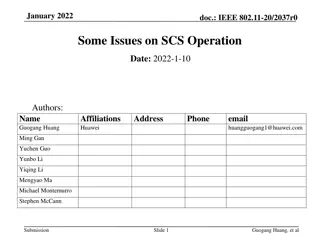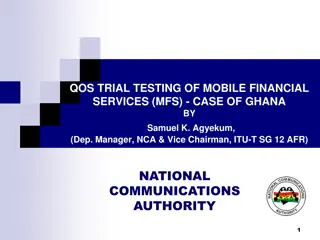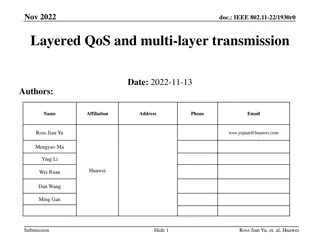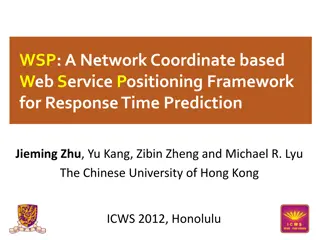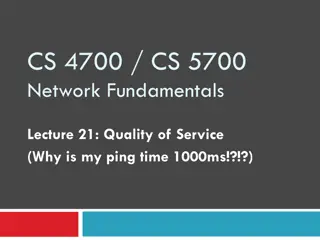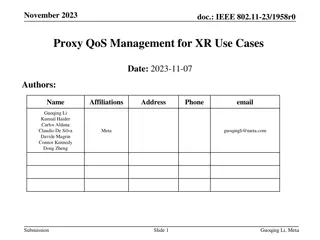
Enhancing Dynamic QoS Profiles for IEEE 802.11 Networks
Explore how dynamic QoS requirements in applications like video collaboration, real-time gaming, and IoT can be efficiently managed through proposed enhancements for scheduling resources in IEEE 802.11 networks.
Download Presentation

Please find below an Image/Link to download the presentation.
The content on the website is provided AS IS for your information and personal use only. It may not be sold, licensed, or shared on other websites without obtaining consent from the author. If you encounter any issues during the download, it is possible that the publisher has removed the file from their server.
You are allowed to download the files provided on this website for personal or commercial use, subject to the condition that they are used lawfully. All files are the property of their respective owners.
The content on the website is provided AS IS for your information and personal use only. It may not be sold, licensed, or shared on other websites without obtaining consent from the author.
E N D
Presentation Transcript
September 2024 doc.: IEEE 802.11-24/660r0 Dynamic QoS Profiles with SCS Date: 2024-09-10 Authors: Name Binita Gupta Affiliations Cisco Systems Address San Diego, CA, USA Phone email binitag@cisco.com mmsmith@cisco.com Malcolm Smith Cisco Systems brianh@cisco.com Brian Hart Cisco Systems jerhenry@cisco.com Jerome Henry Cisco Systems juzuniga@cisco.com Juan Carlos Zuniga Cisco Systems Submission Slide 1 Binita Gupta et al (Cisco Systems)
September 2024 doc.: IEEE 802.11-24/660r0 Introduction For many applications such as video collaboration, real-time gaming, robotics/ IoT, application QoS requirements can dynamically change at run time E.g. changes to throughput and/or latency requirement based on events/triggers experienced In such cases, AP should be notified of dynamic changes to QoS requirements so that it can better serve & meet QoS across different LL applications AP can more efficiently perform UL/DL scheduling based on dynamic QoS updates and avoid over- allocating or under-allocating resources to STAs SCS+QoS Characteristics is defined for a STA to provide QoS requirements for its traffic flows However, SCS+QoS Char is designed mainly for static/semi-static flows where QoS characteristics remains same or changes infrequently In this presentation we propose enhancements to support dynamic updates to QoS requirements for flows, to enable efficient scheduling for UL and DL resources by the AP Submission Slide 2 Binita Gupta et al (Cisco Systems)
September 2024 doc.: IEEE 802.11-24/660r0 Background: Example Applications with Dynamic QoS Video collaboration A dynamic codec can maximize video encoding level based on network conditions. Client starts with best codec rate (say 4K, ~40 Mbps). During the call, unexpected delay is experienced and dynamic codec decides to downgrade codec rate to 2K (~20 Mbps). Data rate requirement can also dynamically change based on the content changes e.g. a viewer becomes a presenter and is now generating 4K encoded video. Industrial IoT In an industrial IoT manufacturing operation, when a robotics arm is doing more precise task then it needs to meet stringent latency and jitter target. When it is not doing precise task, then its latency requirement is more relaxed or may not need specific latency target. Real-time gaming In a first-person shooter (FPS) game, the data rate requirements go up when there is lot of action in the game and go-down when user is relatively inactive L4S enabled applications Any L4S enabled sender application can dynamically adapt its data rate up or down based on ECN congestion feedback from the receiver In such applications, AP should be notified of dynamic QoS updates for efficient scheduling Server AP Dynamic QoS updates STA Submission Slide 3 Binita Gupta et al (Cisco Systems)
September 2024 doc.: IEEE 802.11-24/660r0 Proposal: Notify AP of Dynamic QoS updates (1) A mechanism is needed that can notify AP of dynamic QoS changes for traffic flows Existing approach: SCS Change mechanism: Currently SCS supports a Change mechanism which can potentially be used to update QoS requirements by sending an updated QoS Characteristics for a traffic flow in SCS Change request However, this can be disruptive for dynamic QoS updates, because any SCS Change would have to go through authorization again at the AP, and can fail or take time to complete (like a new SCS request), impacting flow quality A STA may always request highest resources in the initial SCS+QC (to avoid future rejections), but this would lead to over- allocation of resources and in worst case SCS failure due to resource not being available (both not desired) For applications with dynamic QoS changes, it is desirable that updated QoS requirements can be met by the AP and does not result in SCS rejections when QoS changes happen SCS Change approach also does not provide AP any visibility into the range of QoS requirements by an application, which AP can consider for efficient resource planning across flows, meeting flows dynamic QoS changes Limitation:Updated QoS signalled using SCS Change can be rejected by the AP or take time to complete, and does not provide AP visibility into range of QoS requirements for efficient resource planning Submission Slide 4 Binita Gupta et al (Cisco Systems)
September 2024 doc.: IEEE 802.11-24/660r0 Proposal: Notify AP of Dynamic QoS updates (2) We propose two options to notify AP of dynamic QoS changes, that avoids resource allocation failures and additional delays when QoS changes dynamically Option A: Multiple QoS Profiles in SCS, activated with SCS Change A STA can signal multiple QoS profiles for a flow in the initial SCS request - include multiple QoS Characteristics in SCS Descriptor element, each corresponding to a QoS Profile and providing corresponding QoS parameters Each QoS Profile of an SCS flow is identified by a QoS Profile ID. STA indicates one active QoS Profile in the initial SCS request After receiving an SCS request with multiple QoS profiles, AP would perform authorization for these QoS profiles, and can accept all or a subset of QoS profiles indicated SLA-level preference can also be indicated by the STA (where applicable) for each QoS profile, e.g. meet 4K QoS profile with soft SLA and meet 2K QoS profile with hard SLA AP maintains different QoS profiles and considers these in its resource planning, schedules resources based on active QoS profile. When QoS req. changes dynamically, STA sends an SCS Change request indicating the new active QoS profile ID AP then activates the new QoS profile and allocates resources based on that profile A new SCS Pause request can be defined to pause QoS treatment for an SCS flow when not needed. Later can be resumed by sending SCS Change with a desired QoS profile. Submission Slide 5 Binita Gupta et al (Cisco Systems)
September 2024 doc.: IEEE 802.11-24/660r0 Proposal: Notify AP of Dynamic QoS updates (3) Option B: Multiple QoS Profiles in SCS, activated with A-Control STA follows the same mechanism as in Option A for signaling multiple QoS profiles in the initial SCS request AP would perform authorization for these QoS profiles, and can accept all or a subset of QoS profiles indicated Initial SCS request indicates the active QoS profile at that time Later when QoS requirement changes dynamically for a flow, STA indicates this change in-band using A-Control A new A-Control field can signal the SCS ID and the QoS profile ID for the new active QoS profile A-Control can also be designed to dynamically pause QoS treatment for an SCS flow (when not needed by the app) and later resume QoS treatment for a specific QoS profile Benefits: Provides fast notification of dynamic QoS updates w/o management frame overhead Submission Slide 6 Binita Gupta et al (Cisco Systems)
September 2024 doc.: IEEE 802.11-24/660r0 Summary There are many applications where QoS requirements can change dynamically (e.g. video collab, real-time gaming, industrial IoT, L4S cloud applications) When QoS requirement changes dynamically, AP needs to be notified so it can perform efficient scheduling for resources in UL and DL to meet QoS requirements across all its flows Existing SCS Change mechanism has the limitation of renegotiating SCS resource for every dynamic QoS updates, which can fail or take time for authorization to complete (both can be disruptive for LL flows) We proposed two mechanisms for notifying AP of dynamic QoS updates for an SCS flow, that avoids resource allocation failures and additional delays when QoS changes Option A: STA provides multiple QoS Profiles in initial SCS request + uses SCS Change later to signal a different active QoS profile Option B: STA provides multiple QoS Profiles in initial SCS request + signals a different active QoS profile in-band in an A-Control field Provides fast notification of dynamic QoS updates w/o management frame overhead Submission Slide 7 Binita Gupta et al (Cisco Systems)
September 2024 doc.: IEEE 802.11-24/660r0 Straw Poll 1 Do you support in 11bn to define a mechanism for a non-AP STA to provide multiple QoS profiles (in the SCS Request) each indicating a different set of QoS characteristics parameters for an SCS flow and indicate which QoS profile is active? Submission Slide 8 Binita Gupta et al (Cisco Systems)
September 2024 doc.: IEEE 802.11-24/660r0 Straw Poll 2 Do you support in 11bn to define a mechanism for a non-AP STA to dynamically update the active QoS profile for an SCS flow by signaling a different QoS profile to the AP from one of the previously provided (and accepted) QoS profile for that flow? Submission Slide 9 Binita Gupta et al (Cisco Systems)


